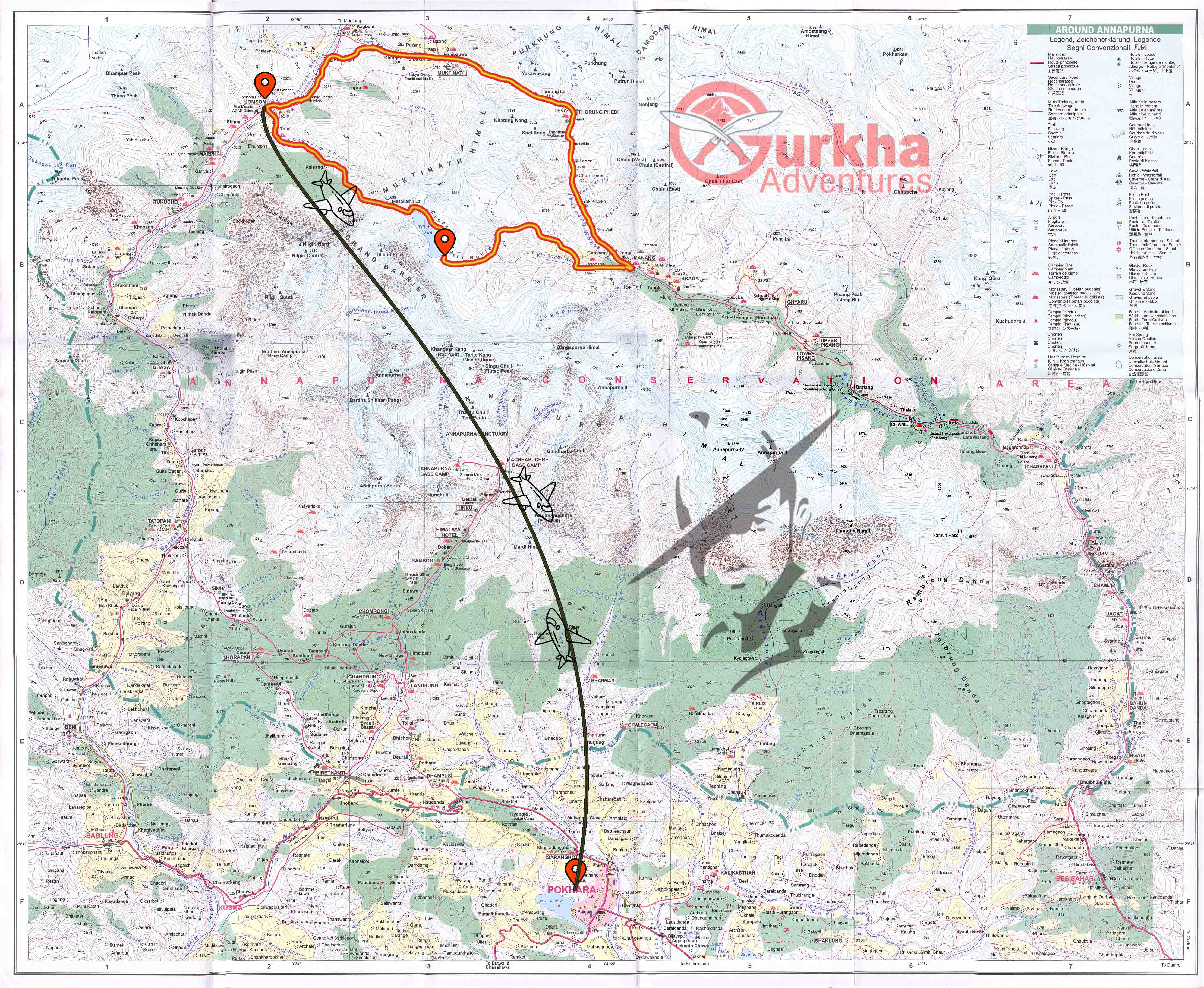Jomsom Annapurna Circuit Trek
14 days
5416 M

Hard
Embarking on a remarkable adventure, the trek from Jomsom to Tilicho Lake, Manang, Yakkharka, Thorong Phedi, Thorong La Pass, and back to Jomsom offers an awe-inspiring journey through the majestic landscapes of the Annapurna region in Nepal. This trek is a perfect blend of natural beauty, cultural exploration, and thrilling challenges, promising an unforgettable experience for trekkers seeking both physical and spiritual gratification.
The journey begins in Jomsom, a picturesque town nestled in the Kali Gandaki Valley. Trekkers commence their ascent towards the pristine Tilicho Lake, one of the highest lakes in the world. The trail leads through arid landscapes, barren hillsides, and dramatic gorges, captivating adventurers with its rugged charm. En route, trekkers will catch glimpses of snow-capped peaks, including the magnificent Annapurna and Dhaulagiri ranges, creating a breathtaking backdrop throughout the trek.
As the trek continues, the trail meanders through Manang, a culturally rich village renowned for its Buddhist monasteries, traditional stone houses, and warm hospitality. Here, trekkers can immerse themselves in the unique local culture, interact with the friendly residents, and savor authentic Nepalese cuisine. The exploration of Manang offers trekkers a chance to acclimatize to the increasing altitude and witness the harmonious coexistence of nature and human settlements.
Leaving Manang behind, the trek proceeds to Yakkharka, a small hamlet nestled amidst alpine meadows and surrounded by towering peaks. The village is a sanctuary for yaks, which are commonly used as pack animals in this region. Trekkers will be mesmerized by the tranquil atmosphere and the sight of these gentle creatures grazing in the high-altitude pastures.
The next phase of the journey takes trekkers to Thorong Phedi, the base camp for the renowned Thorong La Pass. As the altitude increases, the landscape transforms into a rugged terrain with snowy peaks, frozen rivers, and vast glaciers. The final ascent to Thorong La Pass is challenging but rewarding, requiring physical endurance and mental fortitude. Standing at an elevation of 5,416 meters (17,769 feet), the pass offers unparalleled panoramic views of the surrounding Himalayan peaks, an experience that leaves trekkers in awe of nature's grandeur.
Having conquered Thorong La Pass, trekkers descend towards Jomsom, retracing their steps through the diverse landscapes they previously encountered. This section of the trek allows time for reflection and appreciation of the journey's accomplishments while enjoying the ever-changing vistas.
The Jomsom to Tilicho Lake, Manang, Yakkharka, Thorong Phedi, Thorong La Pass, and back to Jomsom trek is a testament to the indomitable spirit of adventure and the enchanting beauty of the Annapurna region. It provides trekkers with an opportunity to immerse themselves in the rich cultural heritage, traverse diverse landscapes, and witness the incredible natural wonders that Nepal has to offer. It is an experience that promises memories to last a lifetime and leaves trekkers with a profound sense of achievement and reverence for the mighty Himalayas.
Includes and excludes :
Includes:
- All meals as specified for trek (breakfast, lunch, dinner with tea/coffee).
- Arrival pick up & departure.
- All internal local transport as per the itinerary.
- Internal flights
- All trekking arrangements including trekking permits, climbing permits, National Park entrance fees.
- Accommodation in twin sharing local lodges or best available places for accommodation,
- Trekking & Climbing leader & porter (salary, insurance, food, accommodation & other allowances).
- Basic first aid kit is carried by your leader.
- All hard ware gears
Excludes:
- Kathmandu food lunch & dinner,
- International flights to Kathmandu,
- Tips for Porter, guide & other
- Personal climbing gears and climbing boot, clothing & equipment
- Personal expenditure, all bar bills, laundry, telephone calls, hot shower in the mountain region, mineral water, snacks, desserts.
- Medical examination (if required) & vaccination costs
- Optional trips. Charges incurred as a result of delays beyond our control
- Visa fees & Travel insurance. Airport taxes
- Meals or drinks except the 3 main meals specified in itinerary
- Anything else not specified in the ‘included costs’ section above
For more details
Itinerary breakdown
Jomsom Annapurna Circuit
Day 01: Drive from Kathmandu to Pokhara and overnight hotel
Day 02: Fly to Jomsom {2713m} and overnight at teahouse lodge
Day 03: we trek to Tinigaon {2630m) – 1-2 hrs
Day 05: Trek to Kaisang – {3510m} – a day for rest and acclimatization
Day 06: Trek to the western pass {4920m} and camp at the lake – 4 hrs
Day 07: Trek to Tilicho Base Camp {4200m} – 5 hrs
Day 08: Trek to Yak Kharka – {4000m} – 5 hrs
Day 09: Trek to Thorung Phedi – {4450m} – 5 hrs
Day 10: Jomsom via Thorung La pass to Muktinath {3800m} – 8 hrs
Day 11: Fly out to Pokhara
Day 12: Drive or fly to Kathmandu





